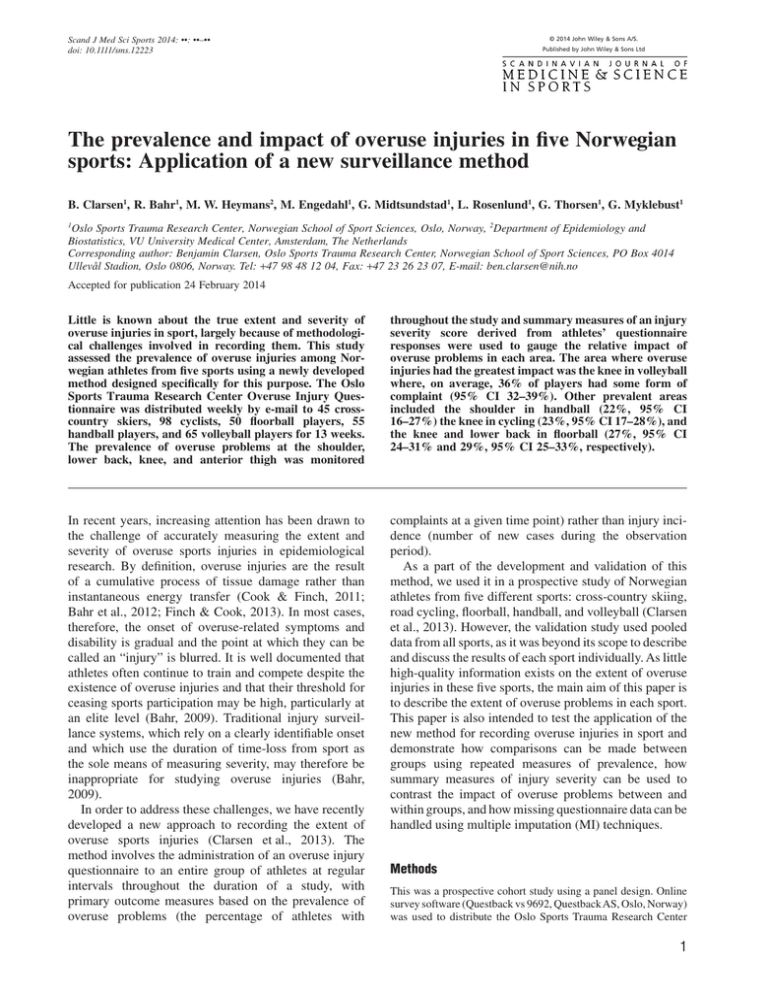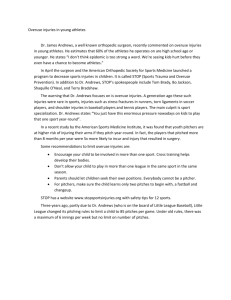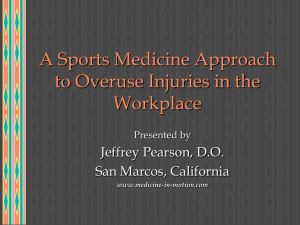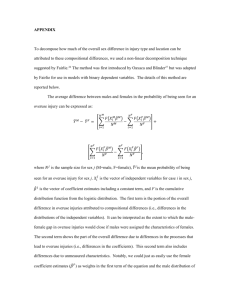The prevalence and impact of overuse injuries in five Norwegian
advertisement

© 2014 John Wiley & Sons A/S. Scand J Med Sci Sports 2014: ••: ••–•• doi: 10.1111/sms.12223 Published by John Wiley & Sons Ltd The prevalence and impact of overuse injuries in five Norwegian sports: Application of a new surveillance method B. Clarsen1, R. Bahr1, M. W. Heymans2, M. Engedahl1, G. Midtsundstad1, L. Rosenlund1, G. Thorsen1, G. Myklebust1 Oslo Sports Trauma Research Center, Norwegian School of Sport Sciences, Oslo, Norway, 2Department of Epidemiology and Biostatistics, VU University Medical Center, Amsterdam, The Netherlands Corresponding author: Benjamin Clarsen, Oslo Sports Trauma Research Center, Norwegian School of Sport Sciences, PO Box 4014 Ullevål Stadion, Oslo 0806, Norway. Tel: +47 98 48 12 04, Fax: +47 23 26 23 07, E-mail: ben.clarsen@nih.no 1 Accepted for publication 24 February 2014 Little is known about the true extent and severity of overuse injuries in sport, largely because of methodological challenges involved in recording them. This study assessed the prevalence of overuse injuries among Norwegian athletes from five sports using a newly developed method designed specifically for this purpose. The Oslo Sports Trauma Research Center Overuse Injury Questionnaire was distributed weekly by e-mail to 45 crosscountry skiers, 98 cyclists, 50 floorball players, 55 handball players, and 65 volleyball players for 13 weeks. The prevalence of overuse problems at the shoulder, lower back, knee, and anterior thigh was monitored throughout the study and summary measures of an injury severity score derived from athletes’ questionnaire responses were used to gauge the relative impact of overuse problems in each area. The area where overuse injuries had the greatest impact was the knee in volleyball where, on average, 36% of players had some form of complaint (95% CI 32–39%). Other prevalent areas included the shoulder in handball (22%, 95% CI 16–27%) the knee in cycling (23%, 95% CI 17–28%), and the knee and lower back in floorball (27%, 95% CI 24–31% and 29%, 95% CI 25–33%, respectively). In recent years, increasing attention has been drawn to the challenge of accurately measuring the extent and severity of overuse sports injuries in epidemiological research. By definition, overuse injuries are the result of a cumulative process of tissue damage rather than instantaneous energy transfer (Cook & Finch, 2011; Bahr et al., 2012; Finch & Cook, 2013). In most cases, therefore, the onset of overuse-related symptoms and disability is gradual and the point at which they can be called an “injury” is blurred. It is well documented that athletes often continue to train and compete despite the existence of overuse injuries and that their threshold for ceasing sports participation may be high, particularly at an elite level (Bahr, 2009). Traditional injury surveillance systems, which rely on a clearly identifiable onset and which use the duration of time-loss from sport as the sole means of measuring severity, may therefore be inappropriate for studying overuse injuries (Bahr, 2009). In order to address these challenges, we have recently developed a new approach to recording the extent of overuse sports injuries (Clarsen et al., 2013). The method involves the administration of an overuse injury questionnaire to an entire group of athletes at regular intervals throughout the duration of a study, with primary outcome measures based on the prevalence of overuse problems (the percentage of athletes with complaints at a given time point) rather than injury incidence (number of new cases during the observation period). As a part of the development and validation of this method, we used it in a prospective study of Norwegian athletes from five different sports: cross-country skiing, road cycling, floorball, handball, and volleyball (Clarsen et al., 2013). However, the validation study used pooled data from all sports, as it was beyond its scope to describe and discuss the results of each sport individually. As little high-quality information exists on the extent of overuse injuries in these five sports, the main aim of this paper is to describe the extent of overuse problems in each sport. This paper is also intended to test the application of the new method for recording overuse injuries in sport and demonstrate how comparisons can be made between groups using repeated measures of prevalence, how summary measures of injury severity can be used to contrast the impact of overuse problems between and within groups, and how missing questionnaire data can be handled using multiple imputation (MI) techniques. Methods This was a prospective cohort study using a panel design. Online survey software (Questback vs 9692, QuestbackAS, Oslo, Norway) was used to distribute the Oslo Sports Trauma Research Center 1 Clarsen et al. Overuse Injury Questionnaire (Clarsen et al., 2013) to all athletes in the study each week for 13 weeks during the period October 2010–March 2011. E-mails linking athletes to the questionnaire were sent every Sunday, and a reminder e-mail sent to nonresponders 3 days later. The questionnaire consisted of four questions on each anatomical area of interest (Clarsen et al., 2013); athletes in all groups received questions related to the knee, lower back, and shoulder, while cyclists and cross-country skiers also received questions on the anterior thigh. The complete questionnaire is available as online Supporting Information to this article. Within a month of the final questionnaire, all athletes were contacted by a physiotherapist for a telephone interview to review their questionnaire responses and determine the type and nature of each problem reported. Based on these interviews, all cases were classified as either acute or overuse injuries and separate datasets were created for each injury type. Acute injuries were defined as those associated with a specific, clearly identifiable injury event. All other cases were regarded as overuse injuries, regardless of whether their onset was gradual or rapid. Recurrent overuse conditions at the same location and of the same nature were treated as a single case despite periods of symptom remission (Finch & Cook, 2013). Participants All study participants competed on the highest level of competition in Norway at either a senior or under-19 (junior) level. The cross-country skiers (n = 45) were recruited from a junior team representing the Oslo region. Road cyclists (n = 98) were recruited from five semi-professional teams, one professional women’s team, and five junior teams. Floorball players (n = 50) were recruited from men’s and women’s elite club teams and the junior men’s team from a large club in Oslo. This was similar for handball players (n = 55), who were recruited from the men’s and women’s elite teams and junior women’s teams from an Oslo club. Volleyball players (n = 65) were recruited from a special boarding school that combines a 3-year senior high school program with daily volleyball training for all students. The teams included in the study were a convenience sample and there was a wide variation in the distribution of athletes’ age, sex, height, body mass, and number of years of participation in the sport between the five groups, as shown in Fig. 1. The study was approved by the Norwegian Data Inspectorate and reviewed by the South-Eastern Norway Regional Committee for Research Ethics. All athletes provided written informed consent to participation. Prevalence measures The prevalence of overuse problems was calculated for each anatomical area each week of the study by dividing the number of athletes that reported any problem (i.e., anything but the minimum value in any of the four questions) by the number of questionnaire respondents. Weekly prevalence data were plotted over time to identify trends over the course of the study, and the average weekly prevalence of overuse problems was calculated for each anatomical area and athlete group. As all physical complaints were included in this measure, regardless of their consequence on sports participation or performance, the injury definition used is consistent with the recommendations of methodological consensus statements from a variety of sports (Fuller et al., 2006, 2007; Pluim et al., 2009). A second prevalence measure was also calculated for each anatomical area and sporting group; the average prevalence of substantial overuse problems. This was calculated and expressed in the same way as described above. However, the numerator in the prevalence calculations only included overuse problems leading to (self-reported) moderate or severe reductions in training volume or 2 Fig. 1. Boxplot comparisons of the demographic characteristics of males (white boxes) and females (shaded boxes) from each of the five sports; cross-country (XC) skiing (29 males/16 females), cycling (84/14), floorball (33/17), handball (19/36), and volleyball (27/38). sporting performance, or a total inability to participate (i.e., responses 3, 4, or 5 in either question 2 or 3). This was done in order to filter out the most minor overuse problems from prevalence measures. Relative impact of overuse problems Every time an athlete responded to a questionnaire, a severity score was calculated for each anatomical area, based on their responses to the four key questions (Clarsen et al., 2013). At the conclusion of the study, a cumulative severity score was calculated for each area for each sporting group by summing athletes’ severity scores over the 13 weeks, adjusted for differing group sizes and response rates. These scores were compared as an assessment of the relative impact of overuse problems in each anatomical area within and between sports. The prevalence of overuse injury Statistical procedures Missing data Preliminary analyses showed that, on average, 6.6% of data were missing in each of the repeated outcome measures and that 19% of subjects had incomplete datasets. The patterns of missing data were then analyzed in two ways. Firstly, univariate and multivariable logistic regression analyses were performed to assess whether baseline variables (sport, gender, age and years of sports participation) were associated with missing follow-up data. Secondly, logistic regression analyses were performed to evaluate if outcome data at specific follow-up points were related to missing data at the next follow-up point. These analyses revealed that demographic characteristics were not statistically predictive of incomplete data. However, nonresponse to one questionnaire was predictive of nonresponse the following week. This indicated that information from previous outcome measures could be used to predict outcome at later time points, which is a strong reason for assuming it to be of the type “missing at random” (van Buuren, 2012). We therefore used the MI method to handle the missing data, which led to the pooled results of five multiple imputed datasets. MI was based on the Multivariate Imputation by Chained Equation algorithm in combination with a predictive mean matching approach, as currently implemented in SPSS statistical software (SPSS V.21, IBM Corporation, New York, USA; van Buuren, 2012). Sensitivity analyses were performed comparing the MI results with completecase analyses (i.e., deleting each case with missing data before the analysis). As these analyses showed no differences in results, we chose to report all statistical analyses using the imputed data. Comparison of sporting groups In order to assess differences in the prevalence of all overuse problems and substantial overuse problems between sporting groups over time, generalized estimating equations (GEE) were performed using SPSS software. GEE accounts for the correlation of repeated outcome measures within subjects over time. We chose GEE in preference to a generalized linear mixed model because we were interested in group-averaged compared with person-specific relationships. Subject age, gender, years of sports participation, height, and weight were included in the GEE models, as univariate analyses of each of these factors revealed a possible association with the various injury outcomes over time (P < 0.2). An exchangeable covariance matrix was used and the significance level (α) was 0.05 for all analyses. Results Response rate The response rate to the 13 weekly questionnaires was 96% in cross-country skiing, 92% in cycling, 90% in floorball, 98% in handball, and 91% in volleyball. Eighty-one percent of athletes answered all 13 questionnaires and 91% answered 11 or more. Prevalence of overuse problems The prevalence of all overuse problems and of substantial overuse problems in each anatomical location over the 13 weeks is illustrated in Fig. 2. As illustrated in the figure, the prevalence of all problems tended to be highest at the beginning of the study in all groups, whereas the prevalence of substantial problems remained relatively stable throughout the 13 weeks. Fig. 2. Prevalence of all overuse problems (light gray area) and substantial overuse problems (dark gray area) located in the knee, lower back, shoulder, and anterior thigh in each of the five sports over 13 weeks. 3 Clarsen et al. Table 1. Average prevalence of all overuse problems and of substantial problems, % (95% CI) All overuse problems Knee Lower back Shoulder Anterior thigh Substantial overuse problems Knee Lower back Shoulder Thigh XC skiing Cycling Floorball Handball Volleyball 8 (5–11) 5 (2–9) 1 (0–3) 12 (8–15) 23 (17–28) 16 (12–20) 7 (4–10) 8 (7–9) 27 (24–31) 29 (25–33) 15 (9–20) 20 (16–25) 12 (8–16) 22 (16–27) 36 (32–39) 14 (11–16) 16 (14–19) 1 (0–2) 1 (1–2) 1 (0–1) 7 (5–8) 8 (7–9) 6 (4–7) 1 (0–1) 4 (3–5) 4 (2–6) 3 (1–4) 1 (0–2) 8 (6–10) 2 (1–3) 6 (4–8) 15 (13–17) 1 (1–2) 5 (4–6) Substantial overuse problem: causing moderate/severe reductions in training volume or sports performance, or complete inability to participate in training or competition. XC, cross-country. Inter-sport comparisons The odds ratios of experiencing overuse problems between each sport are shown in Table 2. All calculations are adjusted for the effect of athletes’ demographic characteristics. Table 3 shows the relationships between demographic characteristics and the various injury outcomes, based on multivariable GEE analyses. As shown in the table, female athletes had a reduced risk of substantial knee and lower back problems, lighter athletes had an increased risk of substantial knee problems, and heavier athletes had an increased risk of thigh problems and substantial thigh problems. Discussion Fig. 3. Relative impact of overuse problems located in the knee, lower back, shoulder, and anterior thigh between the different sporting groups, shown as the adjusted cumulative severity score for each group. CX, cross-country skiing; CY, road cycling; FB, floorball; HB, handball; VB, volleyball. Table 1 shows the average prevalence of all overuse problems and of substantial overuse problems for each anatomical area in all sports. Relative impact of overuse problems Figure 3 shows the relative impact of overuse problems in each anatomical area for each sport, based on the adjusted cumulative severity score over the 13-week study. As shown in the figure, knee problems among volleyball players had the greatest relative impact. 4 In this paper, we have measured the prevalence and impact of overuse problems across a variety of sports using a new method designed specifically for this purpose. Comparisons were made between groups primarily in order to illustrate how the new method can be applied for this purpose. Several particular problem areas were identified, such as knee complaints among the volleyball players, which was the most prevalent overuse problem that we measured and clearly the one posing the greatest impact on the athletes. While this finding is supported by those of previous studies that used different methods of data collection, in other cases, our results were contrary to previous reports. The rate of overuse problems was generally low among cross-country skiers, with the lowest prevalence of knee, shoulder, and lower back problems of all the sports. The latter finding contrasts with several previous studies, which suggest that lower back pain may be a particular problem among high-level cross-country skiers (Orava et al., 1985; Eriksson et al., 1996; Bahr et al., 2004; Bergstrom et al., 2004; Alricsson & Werner, 2005, 2006). However, of these investigations, four did not consider the extent to which lower back pain affected participation and skiing performance, and one of the two that did so concluded that while back pain was relatively common among young elite skiers, its effect The prevalence of overuse injury Table 2. Multivariable adjusted odds ratios of overuse problems in the knee, lower back, shoulder, and anterior thigh between the five different sports Knee problems (all overuse) Cycling (ref) Floorball (ref) Handball (ref) Volleyball (ref) Substantial overuse knee problems Cycling (ref) Floorball (ref) Handball (ref) Volleyball (ref) Lower back problems (all overuse) Cycling (ref) Floorball (ref) Handball (ref) Volleyball (ref) Substantial overuse lower back problems Cycling (ref) Floorball Handball (ref) Volleyball (ref) Shoulder problems (all overuse) Cycling (ref) Floorball (ref) Handball (ref) Volleyball (ref) Substantial overuse shoulder problems Cycling (ref) Floorball (ref) Handball (ref) Volleyball (ref) Anterior thigh problems (all overuse) Cycling (ref) Substantial overuse anterior thigh problems Cycling (ref) XC skiing Cycling Floorball Handball 0.43 (0.16–1.13) 0.42 (0.16–1.13) 0.36 (0.14–0.93)* 0.18 (0.07–0.49)* 0.98 (0.50–1.90) 0.83 (0.33–2.08) 0.43 (0.21–0.86)* 0.85 (0.33–2.17) 0.44 (0.19–1.00)* 0.51 (0.22–1.20) 0.30 (0.09–1.04) 0.41 (0.12–1.40) 0.09 (0.03–0.35)* 0.08 (0.02–0.28)* 1.36 (0.56–3.34) 0.32 (0.08–1.35) 0.27 (0.10–0.70)* 0.23 (0.06–0.83) 0.20 (0.07–0.54)* 0.85 (0.29–2.52) 0.57 (0.20–1.62) 0.35 (0.13–0.92)* 0.66 (0.25–1.71) 0.68 (0.25–1.90) 0.60 (0.32–1.15) 1.14 (0.45–2.88) 1.19 (0.56–2.52) 1.90 (0.77–4.68) 1.98 (0.83–4.63) 1.04 (0.41–2.63) 0.29 (0.07–1.25) 0.64 (0.14–2.84) 0.60 (0.15–2.36) 0.33 (0.08–1.43) 2.17 (0.90–5.23) 2.05 (0.68–2.35) 1.13 (0.40–3.17) 0.94 (0.26–3.39) 0.52 (0.14–1.92) 0.55 (0.18–1.71) 0.20 (0.04–0.93)* 0.10 (0.02–0.43)* 0.08 (0.02–0.30)* 0.11 (0.02–0.54)* 0.49 (0.25–0.97)* 0.39 (0.16–0.91)* 0.57 (0.25–1.33) 0.78 (0.34–1.77) 1.15 (0.48–2.78) 1.48 (0.63–3.48) 1.02 (0.09–11.63) 0.35 (0.06–2.16) 0.08 (0.02–0.36)* 0.24 (0.02–0.83)* 0.35 (0.06–2.06) 0.08 (0.01–0.51)* 0.13 (0.02–0.99)* 0.24 (0.07–0.76)* 0.38 (0.07–2.12) 1.61 (0.44–5.95) 1.48 (0.46–4.79) 1.85 (0.43–7.99) *P < 0.05. All data are odds ratios with 95% confidence intervals in parentheses. Based on GEE analyses adjusted for age, sex, years of sports participation, height, and weight. Ref, reference group; XC, cross-country. Table 3. Multivariable analyses of the effect of demographic variables on the odds ratios for overuse and substantial overuse problems Female sex All overuse problems Knee 0.80 (0.38–1.68) Lower back 0.99 (0.45–2.14) Shoulder 1.79 (0.73–4.35) Anterior thigh 0.74 (0.20–2.75) Substantial overuse problems Knee 0.28 (0.11–0.70)* Lower back 0.27 (0.07–0.96)* Shoulder 2.95 (0.55–15.75) Anterior thigh 0.88 (0.13–5.96) Age (year) Participation (year) Height (cm) Body mass (kg) 1.04 (0.97–1.12) 1.06 (0.98–1.15) 1.05 (0.97–1.13) 1.04 (0.93–1.17) 0.96 (0.88–1.04) 0.96 (0.88–1.04) 1.01 (0.93–1.10) 1.00 (0.88–1.14) 1.00 (0.95–1.04) 0.97 (0.93–1.02) 1.01 (0.96–1.07) 0.98 (0.93–1.04) 1.01 (0.97–1.02) 1.02 (0.99–1.04) 1.01 (0.99–1.04) 1.02 (1.01–1.04)* 1.03 (0.95–1.13) 1.02 (0.91–1.13) 1.01 (0.82–1.24) 1.09 (0.94–1.26) 0.95 (0.85–1.06) 1.00 (0.89–1.11) 1.00 (0.83–1.21) 1.03 (0.88–1.21) 1.02 (0.96–1.09) 0.96 (0.90–1.02) 1.04 (0.94–1.15) 0.98 (0.91–1.06) 0.95 (0.90–1.00)* 1.00 (0.94–1.06) 1.01 (0.95–1.07) 1.02 (1.00–1.03)* *P < 0.05. All data are odds ratios per unit change in independent variables, with 95% confidence interval in parentheses. Based on GEE analyses adjusted for sporting group. on their skiing ability was negligible (Eriksson et al., 1996). Based on our results, we concur with this conclusion. In comparison to the knee, lower back, and shoulder, the prevalence of anterior thigh problems was relatively high among the cross-country skiers. While there is little documentation of this in the literature, it is our clinical experience that disabling quadriceps muscle pain and fatigue is a common overuse condition among young elite skiers. This opinion was shared by the coaches of the athletes involved in this study, who specifically asked that questions on the anterior thigh be included for 5 Clarsen et al. cross-country skiers. Our results suggest that this is an area warranting further research. All previous studies of overuse injuries among elite road cyclists have found the knee is a commonly affected area of injury (Callaghan & Jarvis, 1996; Barrios et al., 1997; Clarsen et al., 2010; de Bernado et al., 2012). Our findings certainly support this, given the large number of cyclists that experienced knee problems over the course of the study and the relatively high average prevalence of substantial knee problems. The reported extent to which lower back pain is a problem for elite cyclists varies between studies. We have previously conducted a crosssectional study in which 58% of professional male cyclists reported having experienced lower back pain in the previous 12 months, with 41% reported having sought outpatient medical assistance for it (Clarsen et al., 2010). While the results of the current study give a slightly more conservative estimation of the extent of the problem, the fact that the average prevalence of substantial lower back problems was at least double that of the other sports lends support to our previous conclusion that lower back pain among elite road cyclists is a problem that warrants research attention. Despite the limited amount of research into floorball injuries, three prospective cohort studies have been conducted and all report a relatively low rate of overuse problems (Wikstrom & Andersson, 1997; Snellman et al., 2001; Pasanen et al., 2008). In contrast, we found a high prevalence of overuse problems in the knee, lower back, and shoulder among floorball players. Closer inspection of our data reveals that a vast majority of the overuse problems reported had little consequence on players’ participation or performance, reflected in the low prevalence of substantial overuse problems. However, because of the high prevalence of minor problems over the duration of the project, the overall impact of overuse problems was relatively high compared with other sports, particularly in the lower back and knee. Epidemiological studies of handball players have largely focussed on acute injuries, with few reporting the rate of overuse complaints. However, several prospective cohort studies have found a moderate rate of overuse knee and shoulder injury despite having used a time-loss definition (Nielsen & Yde, 1988; Seil et al., 1998; Møller et al., 2012), and two cross-sectional studies have reported a high prevalence of overuse shoulder complaints among elite players (Gohlke et al., 1993; Myklebust et al., 2013). In the current study, the rate of knee and shoulder problems was high among the handball players, with an average prevalence of 20% and 22%, respectively. As both areas were among the problems representing the greatest overall impact on athletes in this study, future efforts toward their prevention are warranted. A high prevalence of overuse knee injuries is well documented among volleyball players (Lian et al., 2005; Bahr, 2009). Our results strongly support this, being the area with the highest recorded prevalence of overuse 6 problems and of substantial overuse problems. The shoulder and lower back are also reported to be common sites of overuse injury in volleyball (Wang & Cochrane, 2001; Bahr & Reeser, 2003; Verhagen et al., 2004; Bahr, 2009; Reeser et al., 2010). In the current study, we found a relatively high prevalence of shoulder complaints and it is worth noting that the prevalence of substantial shoulder problems was comparable to the handball players. In contrast, the prevalence of lower back problems was low among the volleyball players in this study. This study uses a newly designed method for recording overuse problems based on direct reporting from athletes. This approach allows for the use of a broad, “all physical complaints” definition without the systematic bias that could be expected if third-party injury recorders, such as team medical staff, were used to record injuries (Orchard & Hoskins, 2007). Therefore, this study is perhaps the first to make valid and reliable comparisons of the rate of overuse problems across a variety of different sports. Two methods of comparison were used: GEE and relative impact. The main benefit of using GEE is that, as repeated measures are accounted for, changes in injury prevalence can be assessed over time. In contrast, the relative impact score is a more crude summary measure, which does not account for change over time or confounding. However, it is easy to calculate, takes into account all available data on the consequences of overuse injuries, and allows for comparisons between and within sports that are relatively easy to communicate. For example, among the volleyball players in the current study, the impact of knee problems was more than six times greater than the impact of lower back problems. Similarly, the impact of lower back problems was more than three times greater in cycling than in cross-country skiing. One of the major strengths of this study is that the response rate to the weekly questionnaires was very high, ranging from 91% to 98% across the five sports. Furthermore, the effects of missing questionnaire data were analyzed and MI techniques were used to estimate the studied relationships. We recommend that studies using similar methods employ this approach where possible, as it allows for the inclusion of all athletes’ questionnaire data in statistical analyses, rather than only those with complete responses. This latter method is most frequently used but has proven to give severely biased results (Eekhout et al., 2012). As a minimum standard, studies should report their missing data rate thoroughly and comment on the reasons and likely impact of missing questionnaire responses on the validity of injury data (von Elm et al., 2007; Sterne et al., 2009). It must be recognized that this study has several limitations. Firstly, as the design requires that a limited number of areas of interest be defined a priori, it does not give a complete picture of the extent of overuse injury in the five sports. For example, anterior tibial pain is reported to be common in handball and floorball (Pasanen The prevalence of overuse injury et al., 2008; Møller et al., 2012), but was not registered in this study. As these data were originally collected in order to test and validate the new surveillance method, we chose to include areas that are generally regarded to be common sites of overuse sporting injury. The exception was to include questions on the anterior thigh for the skiers and cyclists, as we saw this as an opportunity to document a potentially important problem for the first time. However, in future studies using these methods, we recommend that the choice of areas to include should be based on previous research, the opinion of key stakeholders in the sport and thorough pilot testing. A second limitation is that we did not record specific diagnoses for the overuse problems that athletes reported. While this is possible and has been done in other studies using similar methods (Clarsen et al., 2014), close follow-up from medical staff is required for the duration of the data collection period and this was beyond the scope of the current study. Instead, we conducted telephone interviews at the study’s conclusion; an approach limited by recall bias and by athletes’ lack of medical expertise. Using this method, we felt confident to categorize problems into overuse and acute injuries, but did not trust that athletes could provide us with a reliable diagnosis themselves. Another limitation to this study is that comparisons have been made between groups of athletes with large differences in their demographic characteristics. As shown in Table 3, in certain cases, athlete characteristics such as sex and body mass were significantly associated with injury outcomes. Even in cases where statistical significance was not found, demographic characteristics were found to have a confounding effect on comparisons of injury prevalence between sports. We therefore recommend that future studies aiming to compare groups of athletes using these methods should make every effort to ensure baseline comparability of athletes’ demographic characteristics and use multivariable models that adjust for their effects. It is also of interest to note that the prevalence of overuse problems fell over the duration of the study in every sport across all anatomical regions. As data collection occurred at slightly different times for each sport and thus the part of the season in which data were collected varied, it is unlikely that this represented a true phenomenon. Instead, we suspect that athletes’ threshold for reporting minor problems increased over the course of the study because of so-called “respondent fatigue” (Ben-Nun, 2008) In contrast, the prevalence of substantial overuse problems was much more stable throughout the course of the study in all areas. This has implications for the interpretation of data from future studies using these methods. A final limitation to this study is the variation in the extent to which each group can be considered representative of all elite Norwegian athletes from that sport. For example, the cohort of cyclists included almost every elite-level cyclist in the country, whereas the floorball and handball players came from a single club and may not be representative of all elite-level players in Norway. Furthermore, it is important to note that this study was only conducted over 3 months and therefore does not account for potential variations in injury prevalence over the entire season. Ideally, studies using this design should include large numbers of subjects and encompass at least one whole season or calendar year. Perspectives This paper reports the prevalence and impact of overuse injuries in cross-country skiing, cycling, floorball, handball, and volleyball. Previous injury studies of these sports have used methods poorly suited to prospective recording of overuse injuries, whereas in this study, we used a new method specifically designed for such a purpose. Our data may therefore represent a more valid picture of the extent of overuse injuries in these sports, and help guide the direction of future injury prevention research. Particular focus should be placed on those areas with the greatest impact, such as the knee in volleyball, the knee and shoulder in handball, the knee and lower back in floorball, and the knee in cycling. This paper also demonstrates how groups of athletes can be compared using the Oslo Sports Trauma Research Center method of recording overuse injuries. Missing data is an important factor to consider when these techniques are used and MI techniques should be considered. This has implications for future studies using these methods of data collection, particularly in risk factor studies and injury prevention trials. Key words: Epidemiology, cross-country cycling, floorball, handball, volleyball. skiing, Acknowledgements The Oslo Sports Trauma Research Center has been established at the Norwegian School of Sport Sciences through generous grants from the Royal Norwegian Ministry of Culture, the South-Eastern Norway Regional Health Authority, the International Olympic Committee, the Norwegian Olympic Committee & Confederation of Sport, and Norsk Tipping AS. References Alricsson M, Werner S. Self-reported health, physical activity and prevalence of complaints in elite cross-country skiers and matched controls. J Sports Med Phys Fitness 2005: 45: 547–552. Alricsson M, Werner S. Young elite cross-country skiers and low back pain – a 5-year study. Phys Ther Sport 2006: 7: 181–184. Bahr R. No injuries, but plenty of pain? On the methodology for recording 7 Clarsen et al. overuse symptoms in sports. Br J Sports Med 2009: 43: 966–972. Bahr R, Alfredson H, Järvinen M, Järvinen T, Khan K, Kjær M, Matheson G, Mæhlum S. Types and causes of injuries. In: Bahr R, ed. The IOC manual of sports injuries: an illustrated guide to the management of injuries in physical activity. Hoboken: Wiley-Blackwell, 2012: 1–25. Bahr R, Andersen SO, Loken S, Fossan B, Hansen T, Holme I. Low back pain among endurance athletes with and without specific back loading – a cross-sectional survey of cross-country skiers, rowers, orienteerers, and nonathletic controls. Spine 2004: 29: 449–454. Bahr R, Reeser JC. Injuries among world-class professional beach volleyball players. The Federation Internationale de Volleyball beach volleyball injury study. Am J Sports Med 2003: 31: 119–125. Barrios C, Sala D, Terrados N, Valenti JR. Traumatic and overuse injuries in elite professional cyclists. Sports Exerc Inj 1997: 3: 176–179. Ben-Nun P. Respondent fatigue. In: Lavrakas P, ed. Encyclopedia of survey research methods. Thousand Oaks: Sage Publications, 2008: 743–744. Bergstrom KA, Brandseth K, Fretheim S, Tvilde K, Ekeland A. Back injuries and pain in adolescents attending a ski high school. Knee Surg Sports Traumatol Arthrosc 2004: 12: 80–85. Callaghan MJ, Jarvis C. Evaluation of elite British cyclists: the role of the squad medical. Br J Sports Med 1996: 30: 349–353. Clarsen B, Krosshaug T, Bahr R. Overuse injuries in professional road cyclists. Am J Sports Med 2010: 38: 2494–2501. Clarsen B, Myklebust G, Bahr R. Development and validation of a new method for the registration of overuse injuries in sports injury epidemiology: the Oslo Sports Trauma Research Centre (OSTRC) overuse injury questionnaire. Br J Sports Med 2013: 47: 495–502. Clarsen B, Rønsen O, Myklebust G, Flørenes TW, Bahr R. The Oslo Sports Trauma Research Center questionnaire on health problems: a new approach to prospective monitoring of illness and injury in elite athletes. Br J Sports Med 2014: 48: 754–760. Cook J, Finch C. The long-term impact of overuse injuries on life-long participation in sport and health status. In: Farelli AD, ed. Sport participation. Hauppauge: Nova Science Publishers, 2011: 85–104. 8 de Bernado N, Barrios C, Vera P, Laíz C, Hadala M. Incidence and risk for traumatic and overuse injuries in top-level road cyclists. J Sports Sci 2012: 30: 1047–1053. Eekhout I, de Boer RM, Twisk JW, de Vet HC, Heymans MW. Missing data: a systematic review of how they are reported and handled. Epidemiology 2012: 23: 729–732. Eriksson K, Nemeth G, Eriksson E. Low back pain in elite cross-country skiers. A retrospective epidemiological study. Scand J Med Sci Sports 1996: 6: 31–35. Finch CF, Cook J. Categorising sports injuries in epidemiological studies: the subsequent injury categorisation (SIC) model to address multiple, recurrent and exacerbation of injuries. Br J Sports Med 2013. doi: 10.1136/bjsports-2012–091729 Fuller CW, Ekstrand J, Junge A, Andersen TE, Bahr R, Dvorak J, Hagglund M, McCrory P, Meeuwisse WH. Consensus statement on injury definitions and data collection procedures in studies of football (soccer) injuries. Br J Sports Med 2006: 40: 193–201. Fuller CW, Molloy MG, Bagate C, Bahr R, Brooks JH, Donson H, Kemp SP, McCrory P, McIntosh AS, Meeuwisse WH, Quarrie KL, Raftery M, Wiley P. Consensus statement on injury definitions and data collection procedures for studies of injuries in rugby union. Clin J Sport Med 2007: 17: 177–181. Gohlke F, Lippert MJ, Keck O. Instability and impingement of the shoulder of the high performance athlete in overhead stress. Sportverletz Sportschaden 1993: 7: 115–121. Lian OB, Engebretsen L, Bahr R. Prevalence of jumper’s knee among elite athletes from different sports: a cross-sectional study. Am J Sports Med 2005: 33: 561–567. Møller M, Attermann J, Myklebust G, Wedderkopp N. Injury risk in Danish youth and senior elite handball using a new SMS text messages approach. Br J Sports Med 2012: 46: 531–537. Myklebust G, Hasslan L, Bahr R, Steffen K. High prevalence of shoulder pain among elite Norwegian female handball players. Scand J Med Sci Sports 2013: 23: 288–294. Nielsen AB, Yde J. An epidemiologic and traumatologic study of injuries in handball. Int J Sports Med 1988: 9: 341–344. Orava S, Jaroma H, Hulkko A. Overuse injuries in cross-country skiing. Br J Sports Med 1985: 19: 158–160. Orchard J, Hoskins W. For debate: consensus injury definitions in team sports should focus on missed playing time. Clin J Sport Med 2007: 17: 192–196. Pasanen K, Parkkari J, Kannus P, Rossi L, Palvanen M, Natri A, Jarvinen M. Injury risk in female floorball: a prospective one-season follow-up. Scand J Med Sci Sports 2008: 18: 49–54. Pluim BM, Fuller CW, Batt ME, Chase L, Hainline B, Miller S, Montalvan B, Renstrom P, Stroia KA, Weber K, Wood TO. Consensus statement on epidemiological studies of medical conditions in tennis, April 2009. Clin J Sport Med 2009: 19: 445–450. Reeser JC, Joy EA, Porucznik CA, Berg RL, Colliver EB, Willick SE. Risk factors for volleyball-related shoulder pain and dysfunction. PM R 2010: 2: 27–36. Seil R, Rupp S, Tempelhof S, Kohn D. Sports injuries in team handball. A one-year prospective study of sixteen men’s senior teams of a superior nonprofessional level. Am J Sports Med 1998: 26: 681–687. Snellman K, Parkkari J, Kannus P, Leppala J, Vuori I, Jarvinen M. Sports injuries in floorball: a prospective one-year follow-up study. Int J Sports Med 2001: 22: 531–536. Sterne JA, White IR, Carlin JB, Spratt M, Royston P, Kenward MG, Wood AM, Carpenter JR. Multiple imputation for missing data in epidemiological and clinical research: potential and pitfalls. BMJ 2009: 338: b2393. van Buuren S. Flexible imputation of missing data. Boca Raton: Chapman & Hall/CRC, 2012. von Elm E, Altman DG, Egger M, Pocock SJ, Gotzsche PC, Vandenbroucke JP. Strengthening the Reporting of Observational Studies in Epidemiology (STROBE) statement: guidelines for reporting observational studies. BMJ 2007: 335: 806–808. Verhagen EALM, Van der Beek AJ, Bouter LM, Bahr RM, van Mechelen W. A one season prospective cohort study of volleyball injuries. Br J Sports Med 2004: 38: 477–481. Wang HK, Cochrane T. A descriptive epidemiological study of shoulder injury in top level English male volleyball players. Int J Sports Med 2001: 22: 159–163. Wikstrom J, Andersson C. A prospective study of injuries in licensed floorball players. Scand J Med Sci Sports 1997: 7: 38–42.





